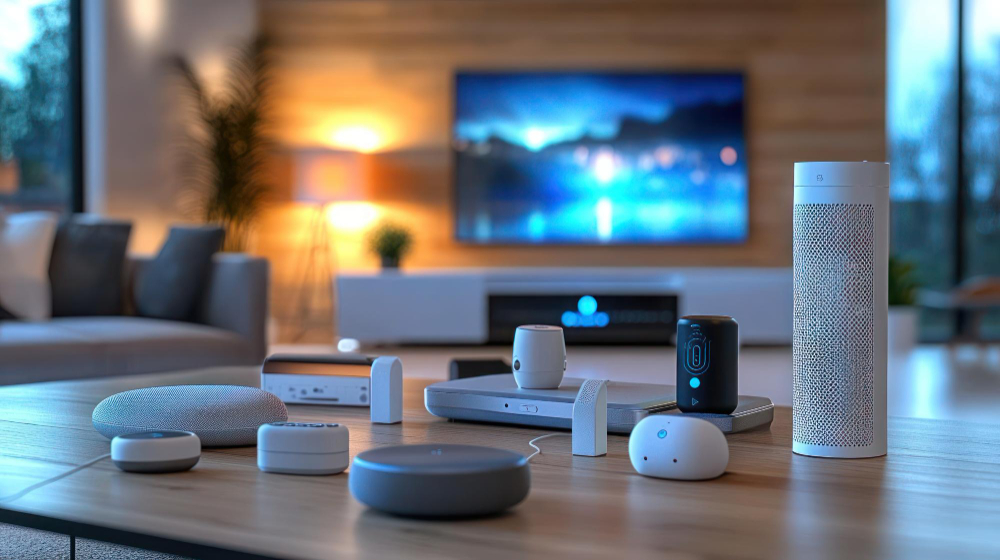To create an ideal projection room, start by selecting an appropriate space with suitable dimensions, ensuring a viewing distance of 1.5 to 2.5 times the screen size. Choose a projector that fits your ambient lighting and resolution needs; aim for at least 2,500 lumens for moderate light. Control ambient light with blackout curtains and minimize reflective surfaces. Arrange seating for comfort and unobstructed sightlines, ideally in a tiered format. Integrate smart technology for seamless control over settings. Regular maintenance and personalized decor further enhance the environment, creating an immersive experience. Explore additional considerations for perfect projection room setups.
Choose the Right Space
When selecting a space for a projection room, it is essential to evaluate several significant factors that will influence both the functionality and effectiveness of the environment.
One of the foremost considerations is the room dimensions. An appropriately sized room is important for accommodating the projection equipment and ensuring ideal viewing distance. A standard recommendation is to maintain a distance of 1.5 to 2.5 times the diagonal screen size to facilitate a comfortable viewing experience.
Moreover, space accessibility plays a fundamental role in the overall design and practicality of a projection room. The room should be easily accessible for both equipment setup and audience entry, allowing for a seamless flow of people and technology.
Adequate pathways should be established to avoid congestion, particularly during events with a large number of attendees.
Additionally, the room should be free of obstructions that may impede sightlines or access to necessary equipment, such as speakers and controls.
Select Your Projector
Choosing the right projector is vital for maximizing the projection room’s visual performance. A significant factor to evaluate is projector brightness, measured in lumens. The brightness level should correspond to the room’s ambient light; for instance, a projector with at least 2,500 lumens is recommended for environments with moderate lighting, while darker settings may require as low as 1,500 lumens.
Next, resolution options play an important role in image clarity and detail. Standard resolutions include SVGA (800×600) for basic presentations, XGA (1024×768) for enhanced clarity, and Full HD (1920×1080) for high-definition viewing. For even finer detail, think about 4K projectors, which deliver four times the resolution of Full HD, making them ideal for cinematic experiences or detailed visuals.
Additionally, evaluate the projector type—LCD, DLP, or LCoS—each offering distinct advantages in color accuracy and contrast. Guarantee compatibility with your content sources and assess the projector’s throw distance for best placement.
Ultimately, selecting the right projector involves a careful balance between brightness, resolution, and specific usage needs to achieve the finest possible viewing experience.
Determine Screen Size
Determining the appropriate screen size is vital for maximizing the viewing experience in a projection room. The ideal screen size is influenced by several factors, including screen distance and viewing angles. A general guideline is to position the screen at a distance that is 1.5 to 2.5 times the diagonal width of the screen. This guarantees that viewers can comfortably perceive details without straining their eyes.
For an immersive experience, the viewing angle should be considered. The best horizontal viewing angle is typically between 30 to 40 degrees. To achieve this, one must calculate the screen size based on the distance from the seating area. For example, if the screen is placed 12 feet away, a screen size of approximately 100 inches diagonal would provide a satisfactory viewing angle.
Additionally, it is important to factor in the resolution of the projector being used. Higher resolutions allow for larger screen sizes without compromising image clarity.
As a result, when determining screen size, take into account both screen distance and the desired viewing angles to create a balanced environment that enhances the overall projection experience.
Optimize Room Layout
Optimizing the room layout is essential for achieving the best possible projection experience. The arrangement of furniture and the utilization of room dimensions play an important role in guaranteeing an immersive viewing environment.
First, it is critical to measure the room dimensions accurately; this information will guide the selection of screen size and projector placement.
When designing the layout, consider the distance between the screen and seating area. A general rule of thumb is to place the seating approximately 1.5 to 2.5 times the diagonal screen size away, allowing for comfortable viewing without straining the eyes.
Furniture arrangement should prioritize unobstructed sightlines and appropriate spacing. Avoid tall furniture or obstacles that may block the view of the screen. Additionally, make sure that all seating is oriented towards the screen to enhance engagement.
Incorporate flexible seating options, such as modular furniture, to accommodate various group sizes and configurations. This adaptability facilitates ideal viewing angles across different scenarios.
Control Ambient Light
While achieving an immersive projection experience relies heavily on the quality of the equipment used, controlling ambient light within the projection room is equally essential. Excessive ambient light can wash out the projected image, diminishing contrast and color fidelity.
To combat this, consider the installation of light blocking curtains. These specialized drapes are designed to prevent external light from infiltrating the room, ensuring that the projected visuals remain vibrant and clear.
Before making any adjustments, utilize ambient light meters to assess the current light levels. These instruments provide precise measurements, allowing you to identify areas where light control is most needed.
Depending on your findings, you may need to implement additional strategies, such as sealing gaps around windows and doors or applying blackout film to glass surfaces.
It is also beneficial to schedule projection sessions during times when natural light is minimal, further enhancing the viewing experience.
Invest in Quality Sound
To achieve a truly immersive projection experience, investing in quality sound equipment is paramount. The auditory aspect of any film or presentation can greatly enhance the overall experience, making it essential to prioritize sound quality alongside visual elements. High-fidelity audio equipment, including speakers, subwoofers, and amplifiers, should be selected based on the size and layout of your projection room.
Consider investing in a surround sound system to create a multidimensional audio experience. This setup typically includes multiple speakers placed strategically around the room, enabling sound to envelop the audience and mimic the acoustics of a professional theater.
Pay attention to the specifications of your audio equipment; look for systems that offer a wide frequency response and low distortion to guarantee clarity and richness in sound reproduction.
Additionally, integrating an AV receiver with advanced audio processing capabilities can further enhance sound quality. Features such as Dolby Atmos or DTS:X can elevate your audio experience, providing a more immersive environment.
Manage Acoustics
Achieving acoustic balance within a projection room is essential for delivering a high-quality audio experience. Proper management of acoustics not only enhances clarity but also prevents sound distortion and echoes that can detract from the viewing experience.
Implementing effective soundproofing techniques is imperative. This includes sealing gaps in walls, windows, and doors to minimize sound leakage, which can greatly impact sound quality.
Incorporating acoustic panels is another important strategy. These panels are designed to absorb sound waves, reducing reflections and reverberations that can muddle audio clarity. Positioning acoustic panels strategically on walls and ceilings can considerably improve sound quality by controlling excessive echo.
A combination of absorption and diffusion materials can be used to create a balanced acoustic environment, ensuring that sound is evenly distributed throughout the room.
Moreover, consider the room’s layout; the placement of furniture and equipment can also influence sound dynamics. Avoid parallel surfaces, as they can create standing waves that disrupt sound fidelity.
Use Proper Wiring
Proper wiring is a critical component in the setup of a projection room, as it directly influences both the audio and visual performance of the system. Confirming that your wiring is done correctly not only enhances the overall experience but also promotes wiring safety, reducing the risk of electrical hazards.
Effective cable management is essential to maintain organization and prevent tangling, which can lead to performance issues and potential damage to your equipment. When planning your wiring layout, consider the following:
| Wiring Type | Purpose |
|---|---|
| HDMI Cables | Transmit high-quality video and audio signals |
| Speaker Wires | Connect audio equipment for peak sound output |
When implementing wiring, confirm that all connections are secure, and use cable ties or conduits to keep cables neatly organized. Additionally, adhere to local electrical codes and standards to guarantee safety. Properly labeled cables can streamline troubleshooting and maintenance, further enhancing the efficiency of your projection room setup. By prioritizing proper wiring, you lay the foundation for an exceptional audiovisual experience.
Set Up Comfortable Seating
With the wiring securely in place, attention now shifts to the arrangement of seating within the projection room. The selection of comfortable seating is paramount for an ideal viewing experience.
Reclining chairs are an excellent option, as they offer the ability to adjust the angle of the backrest, allowing viewers to find their perfect position for comfort during extended viewing sessions.
When choosing reclining chairs, consider models that provide adequate lumbar support and are crafted from breathable materials to enhance comfort. Additionally, incorporating adjustable seating options can cater to diverse viewer preferences and body types, guaranteeing that all guests can enjoy the experience without discomfort.
It is essential to arrange seating in a manner that maximizes sightlines to the screen while also allowing for easy movement within the space. A tiered seating layout can be beneficial, as it prevents obstructions and enhances visibility for all attendees.
To further enhance the experience, make sure that the seating is positioned at an ideal distance from the screen, typically between 1.5 to 2.5 times the screen’s diagonal size. This combination of reclining chairs and adjustable seating will create a welcoming, comfortable environment conducive to immersive viewing.
Incorporate Smart Technology
Incorporating smart technology into the projection room greatly enhances both functionality and user experience. By implementing smart home integration, users can effortlessly control various elements of their projection setup through centralized systems. This technology allows for seamless management of lighting, sound, and projection equipment, creating an immersive environment tailored to individual preferences.
Automated controls play a significant role in optimizing the projection room experience. With programmable settings, users can adjust lighting levels, screen positions, and audio settings with a single command or schedule these adjustments based on specific times or events. For instance, dimming lights and lowering shades can be executed automatically when a movie begins, enhancing visual clarity and ambiance.
Moreover, smart technology facilitates remote access and monitoring, enabling users to manage their projection room from their mobile devices. This integration allows for quick adjustments without interrupting the viewing experience.
Additionally, voice-activated systems can provide hands-free control, further simplifying the operation of complex setups.
Personalize Your Decor
Creating a personalized decor scheme for your projection room allows for a unique expression of style while improving the overall viewing experience. By thoughtfully integrating thematic artwork and a cohesive color scheme, you can transform a standard space into an immersive environment tailored to your preferences.
Begin by selecting a color scheme that complements the mood you wish to create. Consider using darker hues to minimize light reflection, thereby improving image quality. Accent colors can be applied through furniture, curtains, or wall paint, contributing to a cohesive aesthetic.
Incorporate thematic artwork that resonates with your interests, whether it be classic cinema posters, abstract designs, or framed stills from your favorite films. This not only personalizes your space but also creates focal points that enhance visual interest.
Make certain that the artwork is hung at eye level for ideal viewing and is illuminated with subtle lighting to prevent glare on the screen.
Finally, consider the balance of the decor. Aim for an arrangement that does not clutter the space while making sure that each element contributes to an inviting, stylish atmosphere conducive to enjoying your projection room.
Regular Maintenance Tips
Maintaining the integrity and functionality of your projection room is crucial for guaranteeing ideal performance and longevity of your equipment. Establishing a robust maintenance routine is critical, beginning with regular cleaning schedules. Dust and debris can accumulate on lenses, filters, and screens, leading to diminished image quality.
Schedule cleaning at least once a month, using appropriate materials that do not scratch or damage surfaces.
Additionally, implement routine equipment inspections to identify potential issues before they escalate. This includes checking all connections, cables, and mounting hardware for wear and tear. Confirm that the projector’s lamp is functioning effectively and replace it as per manufacturer recommendations to avoid unexpected failures.
Monitor environmental conditions, such as humidity and temperature, which can affect equipment performance. Consider investing in a climate control system if necessary.
Regularly updating software and firmware is also crucial, as these updates often include performance enhancements and security patches.
Frequently Asked Questions
What Is the Best Color for Wall Paint in a Projection Room?
The ideal wall color for a projection room is a matte dark hue, such as deep gray or navy. These colors minimize light reflection, enhancing contrast while promoting a focused atmosphere, in line with color psychology principles.
How Can I Reduce Noise From Outside the Projection Room?
Imagine a fortress of sound, where tranquility reigns. To reduce outside noise, employ soundproofing techniques such as installing acoustic panels, sealing gaps, and using heavy curtains, creating an ideal environment for immersive projection experiences.
Should I Use a Projector Screen or a Blank Wall?
When considering a projector screen versus a blank wall, projector advantages include enhanced image quality and color accuracy. Conversely, wall benefits may encompass cost-effectiveness and the ability to use existing space without additional installation.
How Do I Choose the Right Projector Mount?
Choosing the right projector mount involves evaluating projector height for ideal image alignment and ensuring mount stability to prevent vibrations. Consider the mount’s weight capacity and adjustability to accommodate various projector models and room configurations effectively.
What Are the Best Seating Options for Small Projection Rooms?
In small projection rooms, prioritize space-efficient seating arrangements that maximize comfort. Consider versatile recliner choices that can be easily adjusted, allowing for ideal viewing angles while maintaining a cozy atmosphere without overwhelming the limited area.
Conclusion
In summary, establishing an ideal projection room necessitates careful consideration of various factors, including space selection, projector specifications, and screen dimensions. Attention to ambient light control and seating arrangements enhances the viewing experience. The integration of smart technology streamlines operation, while personalized decor adds character. Regular maintenance guarantees longevity and performance. As the adage goes, “An ounce of prevention is worth a pound of cure,” highlighting the importance of maintenance in preserving the projection room’s functionality and aesthetic appeal.





